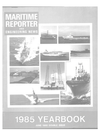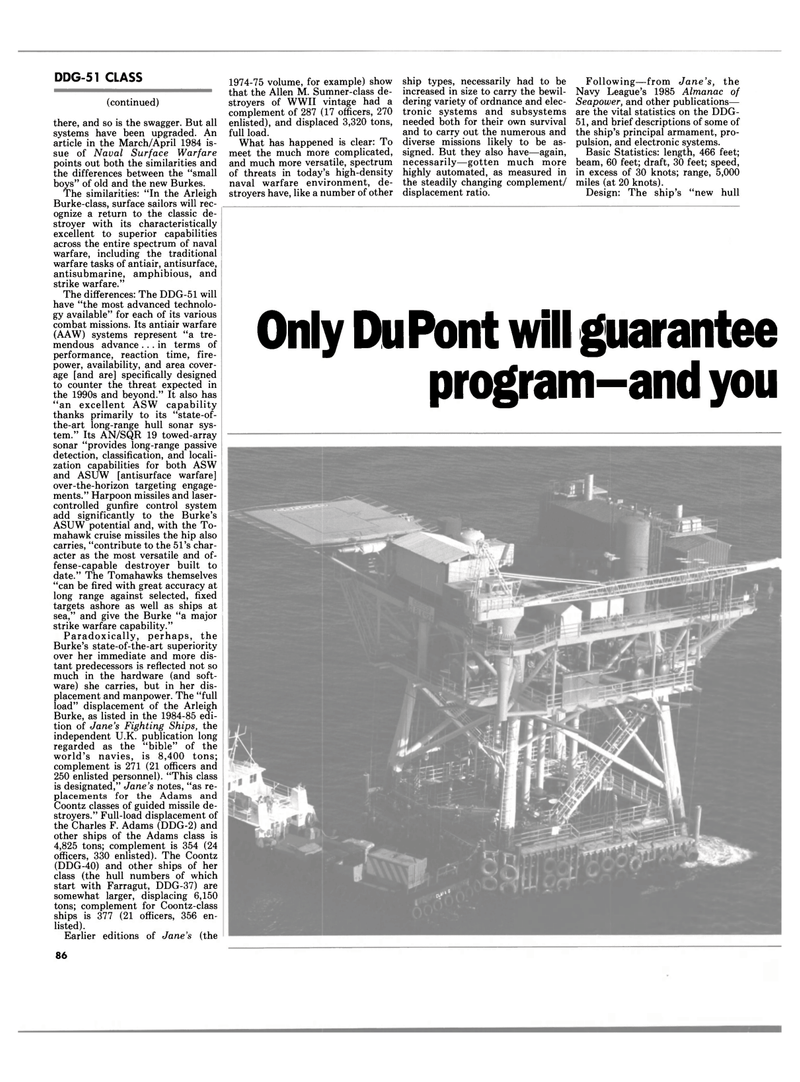
Page 88: of Maritime Reporter Magazine (June 1985)
Read this page in Pdf, Flash or Html5 edition of June 1985 Maritime Reporter Magazine
DDG-51 CLASS (continued) there, and so is the swagger. But all systems have been upgraded. An article in the March/April 1984 is- sue of Naval Surface Warfare points out both the similarities and the differences between the "small boys" of old and the new Burkes.
The similarities: "In the Arleigh
Burke-class, surface sailors will rec- ognize a return to the classic de- stroyer with its characteristically excellent to superior capabilities across the entire spectrum of naval warfare, including the traditional warfare tasks of antiair, antisurface, antisubmarine, amphibious, and strike warfare."
The differences: The DDG-51 will have "the most advanced technolo- gy available" for each of its various combat missions. Its antiair warfare (AAW) systems represent "a tre- mendous advance ... in terms of performance, reaction time, fire- power, availability, and area cover- age [and are] specifically designed to counter the threat expected in the 1990s and beyond." It also has "an excellent ASW capability thanks primarily to its "state-of- the-art long-range hull sonar sys- tem." Its AN/SQR 19 towed-array sonar "provides long-range passive detection, classification, and locali- zation capabilities for both ASW and ASUW [antisurface warfare] over-the-horizon targeting engage- ments." Harpoon missiles and laser- controlled gunfire control system add significantly to the Burke's
ASUW potential and, with the To- mahawk cruise missiles the hip also carries, "contribute to the 51's char- acter as the most versatile and of- fense-capable destroyer built to date." The Tomahawks themselves "can be fired with great accuracy at long range against selected, fixed targets ashore as well as ships at sea," and give the Burke "a major strike warfare capability."
Paradoxically, perhaps, the
Burke's state-of-the-art superiority over her immediate and more dis- tant predecessors is reflected not so much in the hardware (and soft- ware) she carries, but in her dis- placement and manpower. The "full load" displacement of the Arleigh
Burke, as listed in the 1984-85 edi- tion of Jane's Fighting Ships, the independent U.K. publication long regarded as the "bible" of the world's navies, is 8,400 tons; complement is 271 (21 officers and 250 enlisted personnel). "This class is designated," Jane's notes, "as re- placements for the Adams and
Coontz classes of guided missile de- stroyers." Full-load displacement of the Charles F. Adams (DDG-2) and other ships of the Adams class is 4,825 tons; complement is 354 (24 officers, 330 enlisted). The Coontz (DDG-40) and other ships of her class (the hull numbers of which start with Farragut, DDG-37) are somewhat larger, displacing 6,150 tons; complement for Coontz-class ships is 377 (21 officers, 356 en- listed).
Earlier editions of Jane's (the 1974-75 volume, for example) show that the Allen M. Sumner-class de- stroyers of WWII vintage had a complement of 287 (17 officers, 270 enlisted), and displaced 3,320 tons, full load.
What has happened is clear: To meet the much more complicated, and much more versatile, spectrum of threats in today's high-density naval warfare environment, de- stroyers have, like a number of other ship types, necessarily had to be increased in size to carry the bewil- dering variety of ordnance and elec- tronic systems and subsystems needed both for their own survival and to carry out the numerous and diverse missions likely to be as- signed. But they also have—again, necessarily—gotten much more highly automated, as measured in the steadily changing complement/ displacement ratio.
Following—from Jane's, the
Navy League's 1985 Almanac of
Seapower, and other publications— are the vital statistics on the DDG- 51, and brief descriptions of some of the ship's principal armament, pro- pulsion, and electronic systems.
Basic Statistics: length, 466 feet; beam, 60 feet; draft, 30 feet; speed, in excess of 30 knots; range, 5,000 miles (at 20 knots).
Design: The ship's "new hull
Only DuPont will guarantee program-and you 86

 87
87

 89
89
